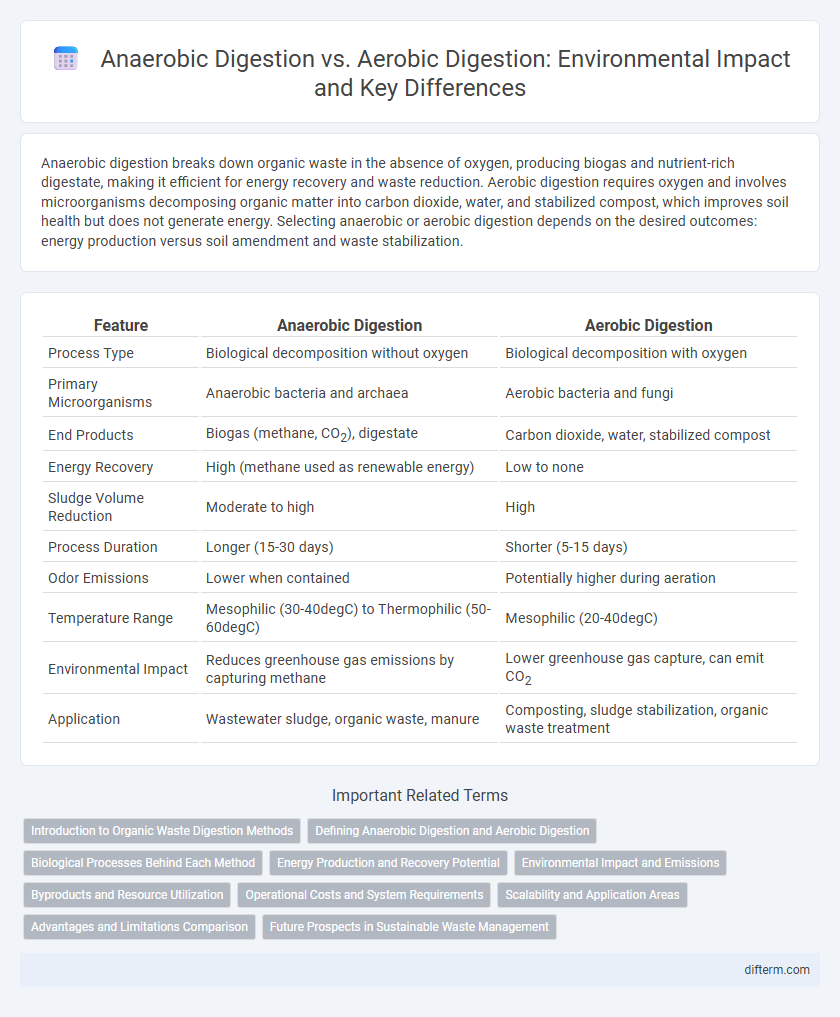Anaerobic digestion breaks down organic waste in the absence of oxygen, producing biogas and nutrient-rich digestate, making it efficient for energy recovery and waste reduction. Aerobic digestion requires oxygen and involves microorganisms decomposing organic matter into carbon dioxide, water, and stabilized compost, which improves soil health but does not generate energy. Selecting anaerobic or aerobic digestion depends on the desired outcomes: energy production versus soil amendment and waste stabilization.
Table of Comparison
| Feature | Anaerobic Digestion | Aerobic Digestion |
|---|---|---|
| Process Type | Biological decomposition without oxygen | Biological decomposition with oxygen |
| Primary Microorganisms | Anaerobic bacteria and archaea | Aerobic bacteria and fungi |
| End Products | Biogas (methane, CO2), digestate | Carbon dioxide, water, stabilized compost |
| Energy Recovery | High (methane used as renewable energy) | Low to none |
| Sludge Volume Reduction | Moderate to high | High |
| Process Duration | Longer (15-30 days) | Shorter (5-15 days) |
| Odor Emissions | Lower when contained | Potentially higher during aeration |
| Temperature Range | Mesophilic (30-40degC) to Thermophilic (50-60degC) | Mesophilic (20-40degC) |
| Environmental Impact | Reduces greenhouse gas emissions by capturing methane | Lower greenhouse gas capture, can emit CO2 |
| Application | Wastewater sludge, organic waste, manure | Composting, sludge stabilization, organic waste treatment |
Introduction to Organic Waste Digestion Methods
Anaerobic digestion involves the breakdown of organic waste by microorganisms in oxygen-free environments, producing biogas primarily composed of methane and carbon dioxide. In contrast, aerobic digestion uses oxygen-dependent microbes to decompose organic matter, resulting in carbon dioxide, water, and stabilized compost. Both methods play essential roles in sustainable waste management by reducing landfill use and generating valuable byproducts like renewable energy and nutrient-rich soil amendments.
Defining Anaerobic Digestion and Aerobic Digestion
Anaerobic digestion is a biological process where microorganisms break down organic matter in the absence of oxygen, producing biogas primarily composed of methane and carbon dioxide. Aerobic digestion involves the decomposition of organic material by bacteria that require oxygen, generating carbon dioxide, water, and stabilized organic matter as end products. Both processes play crucial roles in waste management and renewable energy production, with anaerobic digestion commonly used for biogas generation and aerobic digestion for composting.
Biological Processes Behind Each Method
Anaerobic digestion involves microorganisms breaking down organic matter in the absence of oxygen, producing biogas composed mainly of methane and carbon dioxide. Aerobic digestion relies on aerobic bacteria that decompose organic waste using oxygen, resulting in carbon dioxide, water, and stabilized organic residues. The biological efficiency of anaerobic digestion is driven by methanogenic archaea, while aerobic digestion is dominated by heterotrophic bacteria facilitating rapid oxidation.
Energy Production and Recovery Potential
Anaerobic digestion generates biogas rich in methane, making it a highly efficient process for renewable energy production and recovery from organic waste. Aerobic digestion primarily produces carbon dioxide and heat, resulting in lower energy recovery potential compared to anaerobic digestion. The methane captured from anaerobic digestion can be utilized for electricity, heat generation, or upgraded to biomethane as a sustainable fuel source.
Environmental Impact and Emissions
Anaerobic digestion produces biogas, a renewable energy source that significantly reduces methane emissions compared to traditional waste decomposition. Aerobic digestion, while effective at breaking down organic matter, releases higher levels of carbon dioxide and requires continuous oxygen supply, increasing energy consumption. Anaerobic systems thus offer greater potential for greenhouse gas mitigation and lower environmental impact in waste management.
Byproducts and Resource Utilization
Anaerobic digestion produces biogas, primarily methane and carbon dioxide, which can be utilized as renewable energy, while generating nutrient-rich digestate used as fertilizer, enhancing resource recovery from organic waste. Aerobic digestion primarily produces carbon dioxide and heat, with stabilized compost as a byproduct suitable for soil amendment but with less energy recovery potential. The efficient biogas capture in anaerobic systems offers superior energy valorization compared to the more oxidation-focused nutrient recycling in aerobic processes.
Operational Costs and System Requirements
Anaerobic digestion typically involves higher initial capital investment due to complex sealed reactor systems but offers lower operational costs by producing biogas that can offset energy expenses. Aerobic digestion requires continuous aeration, leading to increased energy consumption and higher ongoing operational costs despite simpler system design. Both methods demand specific infrastructure, with anaerobic systems needing airtight reactors and digestate handling equipment, whereas aerobic systems focus on effective oxygen delivery and aeration machinery.
Scalability and Application Areas
Anaerobic digestion excels in scalability for large-scale waste management facilities and renewable energy production through biogas generation, making it suitable for agricultural, municipal, and industrial applications. Aerobic digestion, while less scalable for large volumes, is preferred for smaller-scale composting and wastewater treatment due to faster organic matter breakdown and lower methane emissions. Both processes serve distinct environmental roles with anaerobic digestion optimized for energy recovery and aerobic digestion for rapid stabilization and nutrient cycling.
Advantages and Limitations Comparison
Anaerobic digestion efficiently converts organic waste into biogas and nutrient-rich digestate, reducing greenhouse gas emissions and providing renewable energy, but it requires strict oxygen-free conditions and longer retention times. Aerobic digestion rapidly decomposes organic matter into carbon dioxide and water with simpler operational control, yet it generates lower energy recovery and produces more greenhouse gases. Both processes contribute to waste management and soil improvement, with anaerobic digestion offering superior energy benefits while aerobic digestion excels in process speed and simplicity.
Future Prospects in Sustainable Waste Management
Anaerobic digestion offers significant future prospects in sustainable waste management by efficiently converting organic waste into biogas, a renewable energy source that reduces reliance on fossil fuels and lowers greenhouse gas emissions. In contrast, aerobic digestion, while effective for stabilizing waste, produces less energy and generates more CO2, making it less favorable for large-scale energy recovery. Advancements in anaerobic digestion technology, including improved microbial consortia and optimized process conditions, are expected to enhance its efficiency and affordability, driving widespread adoption in circular economy frameworks.
anaerobic digestion vs aerobic digestion Infographic

 difterm.com
difterm.com